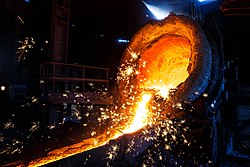| Steels |
|---|
 |
| Phases |
| Microstructures |
| Classes |
| Other iron-based materials |
Cast iron is a class of iron–carbon alloys with a carbon content more than 2%.[1] Its usefulness derives from its relatively low melting temperature. The alloy constituents affect its color when fractured; white cast iron has carbide impurities which allow cracks to pass straight through, grey cast iron has graphite flakes which deflect a passing crack and initiate countless new cracks as the material breaks, and ductile cast iron has spherical graphite "nodules" which stop the crack from further progressing.
Carbon (C), ranging from 1.8 to 4 wt%, and silicon (Si), 1–3 wt%, are the main alloying elements of cast iron. Iron alloys with lower carbon content are known as steel.
Cast iron tends to be brittle, except for malleable cast irons. With its relatively low melting point, good fluidity, castability, excellent machinability, resistance to deformation and wear resistance, cast irons have become an engineering material with a wide range of applications and are used in pipes, machines and automotive industry parts, such as cylinder heads, cylinder blocks and gearbox cases. It is resistant to damage by oxidation but is notoriously difficult to weld.
The earliest cast-iron artefacts date to the 5th century BC, and were discovered by archaeologists in what is now Jiangsu, China. Cast iron was used in ancient China for warfare, agriculture, and architecture.[2] During the 15th century AD, cast iron became utilized for cannon in Burgundy, France, and in England during the Reformation. The amounts of cast iron used for cannons required large-scale production.[3] The first cast-iron bridge was built during the 1770s by Abraham Darby III, and is known as the Iron Bridge in Shropshire, England. Cast iron was also used in the construction of buildings.
https://en.wikipedia.org/wiki/Cast_iron


No comments:
Post a Comment